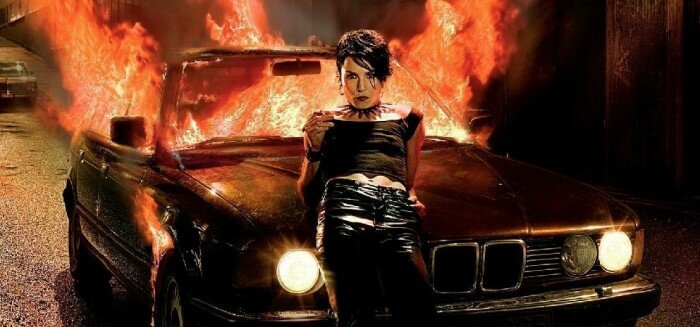The Girl Who Played with Fire hasn’t the Hollywood “I’m tough, but I’m still pretty” fakery. The heroine, Lisbeth Salander (Noomi Rapace), is brutish, burdened and justifiably bitter. She lives in a menacing world of violence, corruption and predatory men, as envisaged by the late Swedish author Stieg Larsson in his immensely popular Millennium trilogy. But with the first film in series, The Girl With the Dragon Tatoo, still fresh in our memories after being released mere months ago in Australia, this swiftly made sequel by director Daniel Alfredson (Wolf, Syndare i sommarsol) suffers a slight case of sequel syndrome.
Alfredson does little to accommodate for series newcomers by choosing not to rehash the all-important character relations established in The Girl With the Dragon Tattoo. In this instalment, investigative journalist Mikael Blomkvist (Michael Nyqvist) is in the final stages of composing an article linking elites to the underage sex trade, when he finds the murdered bodies of the two students who initiated the damning report. Lisbeth, former collaborator and lover of Mikael, is accused of the double murder and the assassination of her former legal guardian, the sadistic Nils Bjurman (Peter Andersson). While Mikael reaffirms his friendship with the untrusting and guarded girl, looking for evidence to clear her name, he learns of the disturbing and cruel treatment of Lisbeth as an institutionalised child. Each works independently to clear her name, and the unlikely pair makes grisly discoveries about Lisbeth’s estranged family.
Lisbeth, the computer hacking, feminist-goth-punk, remains the beating heart of the series. Her daring and ruthlessness assures that the audience remains on her side as she obstinately hunts her repugnant opponents. She is the epitome of cool, and Rapace is a perfect fit within this role. She eloquently portrays toughness with vulnerability. The audience supports her dogged determination and vindictiveness. And she is vindictive; Lisbeth lets no crime go unpunished and we love her for it. Similarly engaging, Nyqvist’s understated performance aptly represents Mikael’s reliability and kindness, in a world of largely brutish men. The actor presents Mikael’s reaction to Lisbeth’s distressing adversities with compassion and empathy, convincing in his unwavering allegiance and support for her. A new character to the series, Ronald Niedermann (Micke Spreitz) is a violent, dim-witted thug that has a rare condition making him conveniently unable to feel physical pain. Whilst this ungentle giant provides a dose of fear through his burly physique, brutality and general aloofness, he is a caricature out of place amongst credible characters.
The film constructs a clever parallel between Lisbeth and Mikael’s own voyage for truth, however, it neglects to utilise the interesting juxtaposition of the odd pair working together. Disappointingly, they share next to no screen time, which was a major point of interest in the first film. When compared with Dragon Tattoo, there are also more far-fetched or “why didn’t he just [fill in the blank]” moments that are at odds with the gritty realism the film projects. Thankfully, revelations within the complex and interwoven storyline occur just in the nick of time as to keep us engaged.
In an upcoming American remake — heaven forbid they should have to read subtitles! – James Bond’s latest incarnation Daniel Craig is rumoured to be playing the role of Mikael. Part of the charm of this film is the Northern European look; the grassy knolls, the historic architecture, the grey menacing skies, the lack of Craig and concomitant blockbuster slick. Yes, I know Craig is British and therefore technically European, but he is quasi-American when you consider his Hollywood output. With the risk of sounding Eurocentric (which, in this case, I blatantly am), I think the Swedes own this one and the Yanks should leave it well enough alone.
Verdict:
Revealing an underworld of sleaze and immorality, The Girl who played with Fire is cleverly intricate and interconnected. It complements and develops on The Girl with the Dragon Tattoo and, therefore, is a must-see for fans of the first film. Whilst its complexity is not as neatly resolved, who can resist another display of Lisbeth’s irrefutable chutzpah?


![girl_who_played_with_fire16[1] girl who played with fire161 e1284475367163 700x295 The Girl Who Played With Fire (Review)](/wp-content/uploads/girl_who_played_with_fire161-e1284475367163-700x295.jpg)













